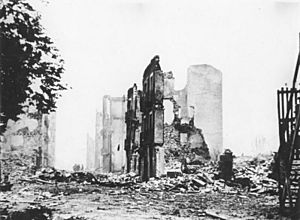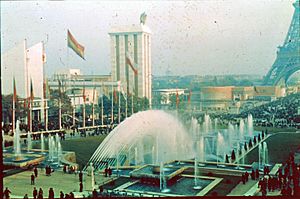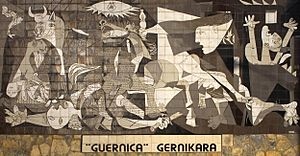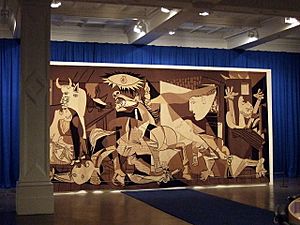Guernica (Picasso) facts for kids
Quick facts for kids Guernica |
|
|---|---|
 |
|
| Artist | Pablo Picasso |
| Year | 1937 |
| Medium | Oil on canvas |
| Movement | Cubism, Surrealism |
| Dimensions | 349.3 cm × 776.6 cm (137.4 in × 305.5 in) |
| Location | Museo Reina Sofía, Madrid, Spain |
Guernica is a very large oil painting from 1937 by the Spanish artist Pablo Picasso. Many art experts believe it is one of the most powerful anti-war paintings ever made. You can see it today at the Museo Reina Sofía in Madrid, Spain.
This huge painting is about 3.5 meters (11.5 feet) tall and 7.7 meters (25.5 feet) wide. It shows the pain and confusion caused by violence and war, using only shades of grey, black, and white. In the painting, you can see a horse in pain, a bull, women screaming, a dead baby, a fallen soldier, and flames.
Picasso painted Guernica in his home in Paris. He created it after hearing about the terrible bombing of Guernica on April 26, 1937. This town in northern Spain was bombed by planes from Nazi Germany and Fascist Italy. They attacked at the request of the Spanish Nationalists during the Spanish Civil War. After it was finished, Guernica was shown at a big art fair in Paris in 1937. It then traveled around the world to help raise money for people affected by the war in Spain. The painting quickly became famous and helped people around the world understand what was happening in the Spanish Civil War.
Contents
Creating the Painting
In January 1937, the Spanish government asked Pablo Picasso to create a large painting for their display at the 1937 Paris World's Fair. The goal was to show the world what was happening in the Spanish Civil War and to raise money for those suffering. Picasso, who was living in Paris at the time, was an important artist. He had not been back to Spain since 1934 and would never return.
Picasso worked on early ideas for the painting from January until April. His first ideas were about an artist's studio. But then, he heard about the bombing of Guernica on April 26. A poet named Juan Larrea visited Picasso and urged him to paint about the bombing instead. A few days later, Picasso read a news report about the attack by George Steer. This report made him change his mind, and he started sketching ideas for Guernica.
The Bombing of Guernica
What Happened on April 26, 1937?
During the Spanish Civil War, different groups in Spain were fighting each other. The Republican forces included communists, socialists, and anarchists. They were united against the Nationalists, led by General Francisco Franco. Franco wanted Spain to return to its old traditions and values.
Guernica was an important town in the Basque Country. It was a center for Basque culture and a key point for the Republican resistance. Because of this, it became a target. On Monday, April 26, 1937, around 4:30 p.m., warplanes from Nazi Germany started bombing Guernica. The attack lasted for about two hours.
A German officer named Wolfram von Richthofen wrote in his diary that the planes dropped bombs right into the town center. Many houses were destroyed, and fires spread quickly. Most people were away for a holiday, or they left quickly when the bombing started. However, other reports say that it was market day, so many people were in the town center. They could not escape because the roads were blocked, and bridges were destroyed.
Guernica was a quiet village, but it was on a key route between the front lines and the city of Bilbao. German forces wanted to stop Republican troops from moving through the town. The nearest military factory was not damaged, which made many people believe the attack was meant to scare people, not just hit military targets. This type of attack is called a terror bombing.
After the Bombing
Most of the men from Guernica were away fighting in the war when the bombing happened. So, the town was mostly filled with women and children. Picasso's painting Guernica shows this, as many of the figures are women and children.
There's a famous story about Picasso during World War II, when Germans occupied Paris. A German officer saw a photo of Guernica in Picasso's apartment and asked, "Did you do that?" Picasso replied, "No, you did." This shows how Picasso felt about the bombing.
How Guernica Was Made
Guernica was painted using a special matte house paint. Picasso wanted it to have very little shine. An American artist, John Ferren, helped him prepare the huge canvas. The photographer Dora Maar also worked with Picasso. She took many photos of the painting as it was being created. These photos helped Picasso decide to use only black and white, making the painting look like a photograph.
Picasso usually did not let people watch him paint. But for Guernica, he allowed important visitors into his studio. He believed that the attention would help the cause against fascism. Picasso explained that the Spanish struggle was about freedom. He said his art was always against "reaction and the death of art." He wanted Guernica to show his strong dislike for the military leaders who had brought so much pain to Spain.
Picasso worked on the painting for 35 days and finished it on June 4, 1937.
What the Painting Shows
The painting shows a scene inside a room. On the left, a wide-eyed bull stands over a sad woman holding her dead child. A horse in the center is falling in pain, with a large hole in its side, as if it was stabbed. The horse seems to be wearing armor.
Under the horse, a dead soldier lies on the floor. His right hand holds a broken sword, but a small flower grows from it, showing a tiny bit of hope. In his left hand, there is a mark that looks like a stigmata, a symbol of suffering. Above the horse's head, a bare light bulb shines like an all-seeing eye, watching the terrible scene.
To the upper right of the horse, a scared woman's head and arm appear to float through a window. She holds a flame-lit lamp, shining light near the bare bulb. From the right side, another woman stumbles towards the center, staring blankly at the bright light.
The horse, the bull, and the grieving woman all have tongues shaped like Daggers, making them look like they are screaming. To the bull's right, a dove can be seen on a cracked wall, with bright light shining through from outside.
On the far right, a fourth woman has her arms raised in fear. Her mouth is wide open, and her head is thrown back, just like the grieving woman's. She is trapped by fire from above and below. Her right hand looks a bit like an airplane.
There are also "hidden" images in Guernica. If you look closely at the horse, its nostrils and upper teeth can look like a human skull. Another hidden image is a bull that seems to be goring the horse from underneath. The bull's head is formed by the horse's front leg, and a horn appears within the horse's chest.
Where Guernica Was Shown
Paris International Exhibition (1937)
Guernica was first shown in July 1937 at the Spanish Pavilion during the Paris International Exposition. This was a huge world fair where countries like Nazi Germany and the Soviet Union had large displays. The Spanish Pavilion, paid for by the Spanish Republican government, was built to show their struggle during the civil war, even though the fair was mostly about technology.
The entrance to the Spanish Pavilion had a giant photo of Republican soldiers and a message about fighting for Spain's unity and independence. Inside, along with Guernica, there were other artworks by artists like Joan Miró and Alexander Calder, who also supported the Republican cause.
When Guernica was first shown in Paris, it didn't get much attention. People had mixed feelings about it. Some Spanish officials didn't like its modern style and wanted a more traditional painting instead. Some groups even criticized Picasso's painting for not being political enough. However, others, like art critic Jean Cassou and poet José Bergamín, loved the painting and called it truly Spanish. Poet Michel Leiris felt that Guernica was a warning about future tragedies.
Traveling Around the World
Picasso was paid for Guernica by the Spanish Republican government. It was one of the few major paintings he didn't sell to his art dealer, Paul Rosenberg. After the Paris exhibition, Rosenberg helped organize a tour of Picasso's works, with Guernica as the main attraction.
From January to April 1938, the painting traveled to cities in Scandinavia like Oslo, Copenhagen, and Stockholm. Then, in late September, Guernica was shown in London at the Whitechapel Art Gallery. It arrived in London on the same day that a major agreement, the Munich Agreement, was signed by leaders of the UK, France, Italy, and Germany. The painting then went to other British cities like Leeds, Liverpool, and Manchester. In Manchester, a group helping people in Spain showed the painting in a car showroom. After that, Guernica returned to France for a short time.
Journey to America
After General Franco won the Spanish Civil War, Guernica was sent to the United States. Its purpose was to raise money and support for Spanish refugees. It was first shown in New York City in May 1939. Then, it had its first museum display at the San Francisco Museum of Art. New York's Museum of Modern Art (MoMA) then held a big exhibition called Picasso: 40 Years of His Art, which included Guernica and its studies.
Picasso asked MoMA to keep Guernica safe. He said the painting should not go back to Spain until the country had freedom and democracy again. So, between 1939 and 1952, Guernica traveled a lot within the United States. It was also shown in Brazil and other major European cities between 1953 and 1956. After all this travel, it returned to MoMA for a special show celebrating Picasso's 75th birthday.
Eventually, people worried about the painting getting damaged from so much travel. So, it was decided to keep it in one place: a special room on MoMA's third floor. It stayed there until 1981. During the Vietnam War, people sometimes held peaceful anti-war protests in the room where Guernica was displayed. On February 28, 1974, a man named Tony Shafrazi sprayed red paint on the painting. Luckily, the paint was easily removed because the painting had a special coating.
Returning to Spain
As early as 1968, General Franco wanted Guernica to come back to Spain. However, Picasso refused. He said the painting would only return when Spain became a republic again. He later added other conditions, like restoring public freedoms and democratic government. Picasso died in 1973, and Franco died two years later in 1975. After Franco's death, Spain became a democratic country with a new constitution in 1978.
Even with these changes, MoMA was hesitant to give up such a famous painting. They argued that a monarchy (even a democratic one) was not the same as the republic Picasso had asked for. But after a lot of pressure, MoMA finally sent the painting to Spain in 1981.
When Guernica arrived in Spain in September 1981, it was first shown behind special bomb-proof and bullet-proof glass screens at the Casón del Buen Retiro in Madrid. This was just in time for Picasso's 100th birthday on October 25. Almost a million people came to see it in the first year. Since then, there have been no attempts to damage the painting.
In 1992, the painting was moved from the Museo del Prado to a special gallery at the Museo Nacional Centro de Arte Reina Sofía, both in Madrid. This move was debated because Picasso's will said the painting should be at the Prado. However, the Prado was moving its 20th-century art to other buildings to make more space. The Reina Sofía, which holds Spain's national collection of 20th-century art, was the natural new home for it. At the Reina Sofía, the painting is protected like any other important artwork.
Some Basque people have asked for the painting to be brought to the Basque Country, especially after the Guggenheim Bilbao Museum was built. However, officials at the Reina Sofía say the canvas is now too delicate to move. Even the staff at the Guggenheim don't think a permanent move is possible, though the Basque government still hopes for a temporary exhibition in Bilbao.
Tapestry at the United Nations
There is a full-size tapestry copy of Picasso's Guernica hanging at the Headquarters of the United Nations in New York City. It is located at the entrance to the Security Council room. This tapestry, made by Jacqueline de la Baume Dürrbach, uses slightly different shades of brown than the original painting.
The Guernica tapestry was first displayed from 1985 to 2009, and then returned in 2015. It was originally ordered in 1955 by Nelson Rockefeller, because Picasso would not sell him the original painting. Rockefeller's family loaned the tapestry to the United Nations in 1985.
On February 5, 2003, a large blue curtain was placed over the tapestry at the UN. This was done so it wouldn't be seen in the background during press conferences by Colin Powell and John Negroponte, who were arguing for war in Iraq. UN officials said the next day that TV news crews asked for the curtain. They complained that the painting's wild lines and screaming figures made a bad background. However, some diplomats told journalists that the US government pressured UN officials to cover the tapestry.
The tapestry was moved for renovations at the UN Headquarters in 2009. It was then shown at the Whitechapel Gallery in London. In 2012, it was loaned to the San Antonio Museum of Art in Texas. It came back to the UN by March 2015. Nelson A. Rockefeller Jr., the owner, took it back in February 2021, but it was returned to the wall outside the UN Security Council in February 2022.
Why Guernica Is Important
In the 1970s, Guernica became a symbol for Spaniards. It represented the end of Franco's rule and the desire for Basque independence. Even today, Basque groups often use images from the painting. For example, the organization Etxerat uses a reversed image of the lamp from the painting as its symbol.
Guernica has become a powerful and worldwide symbol. It warns everyone about the pain and destruction that war causes. The painting doesn't show clear signs of the specific bombing. This makes its message universal and timeless, meaning it applies to all wars, everywhere.
Art experts like Willem Sandberg have said that Picasso created a "new language" in Guernica. He combined different art styles, like expressionism and cubism. Sandberg explained that the painting shows the horror of the air raid using the "language of cubism." This means it uses strong diagonal lines and makes the space feel confusing, like it's both inside and outside at the same time. In 2016, art critic Jonathan Jones called it a "Cubist apocalypse." He said Picasso wanted to show the truth so strongly that it could stand up against the lies told by dictators.
Many other artworks have been inspired by Guernica. These include Faith Ringgold's 1967 painting The American People Series #20: Die, and Goshka Macuga's The Nature of the Beast (2009–2010), which used the UN Guernica tapestry. There are also The Keiskamma Guernicas (2010–2017) and Erica Luckert's play Guernica (2011–2012). An exhibition called Guernica Remakings was held in 2017, showing many works inspired by Picasso's masterpiece.
See also
 In Spanish: Guernica (cuadro) para niños
In Spanish: Guernica (cuadro) para niños
- Guernica, a 1950 film
- The 2018 TV series Genius shows Picasso's life and work, including Guernica
- The Weeping Woman, a 1937 Picasso painting
- The Charnel House, a 1944-45 Picasso painting
- Massacre in Korea, a 1951 Picasso painting
- Dove, a 1949 Picasso print
- The 1980 BBC series 100 Great Paintings
- "Guernica", a 2023 song by Ian Hunter







